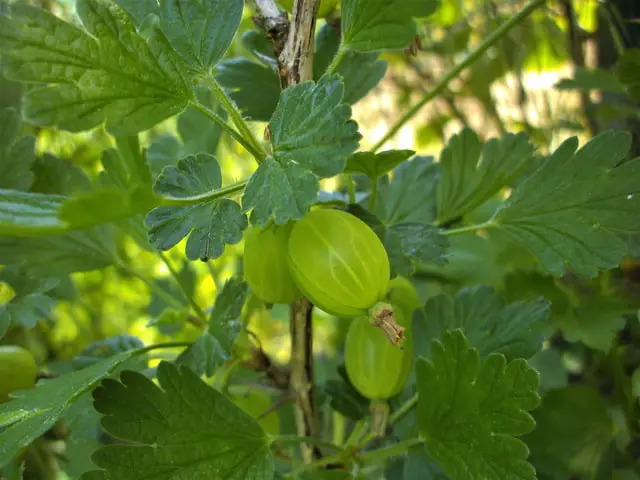Gooseberries are a gardener’s friend. Even a neglectful gardener with little time or effort to lavish can be assured of a reasonable crop of gooseberries. And, of course, growing gooseberries will repay more attention with an even better crop of deliciously juicy fruits.

Jump To...
About Gooseberry Bushes
Gooseberries were first grown in the UK in the sixteenth century and soon became a firm favourite with British cooks.
They were so popular that in the nineteenth century there were clubs of gooseberry growers who competed against each other to develop tastier and juicier fruits.
Many new varieties were created in that time. However, in 1905 the whole UK gooseberry crop, and that of Europe, was decimated by mildew. Fortunately, for gooseberry lovers, mildew resistant plants were reintroduced from America.
Today the Egton Bridge Old Gooseberry Society still hosts an annual gooseberry show, which is the highlight of the year for dedicated gooseberry growers.
Gooseberry Varieties
There are many varieties of gooseberries available and they’re not all green. Gooseberries can be yellow, red or white and even black, although black gooseberry bushes are rare these days.
They can be hairy or smooth, sweet or sour, soft or crisp and early or late fruiting. The golden dessert varieties can be eaten raw like grapes while the sharpness of the cookers makes wonderful crumble and works equally well as a sauce with oily fish such as mackerel.
The varieties Green Gem, Invicta, Lord Derby (red) and Leveller (yellow) all rate highly for flavour. And if you can find it, the old dessert gooseberry, Victoria, is second to none according to gooseberry growing experts.
Growing Gooseberries
A gooseberry bush is very easy to grow. Although it prefers a well drained loam, it will flourish in almost any soil, and doesn’t mind which direction it faces. Dessert gooseberry bushes are an exception to this rule as they like a sunny postion.
- Mulch annually with manure or a good compost.
- Prune the main growth shoots of young plants back by half each winter to encourage strong new growth and get rid of branches that are weak or don’t bear fruit.
- All varieties can be trained into fans or single, double or triple cordons.
- Gooseberry bushes can be propagated easily from cuttings.
Protecting Gooseberries From Pests
Growing gooseberries is generally a very low maintenance job for fruit gardeners.
However, they are vulnerable to attack by some insect pests and diseases. These don’t take a lot of effort to deal with, however.
- Birds, especially bullfinches, blackbirds and robins, love gooseberries. Try creating a flapping screen of strips of plastic as a deterrent or grow the gooseberry bush in a fruit cage. Dessert varieties are particularly appealing to birds so need a good cover.
- Sawfly, caterpillars and aphids can all be problematic but are easily treated with insecticide.
- Mildew can also be a problem in branches and leaves farthest from the light. Keep a close check on these and at first sign of affected fruit, remove the damaged berries to prevent the spread. To avoid mildew make sure the air can circulate freely through the branches.
- If the edges of the leaves appear scorched it may indicate a potash deficiency. Carefully fork in – taking care not to damage the roots – about an ounce of sulphate of potash per grown bush.
Using Gooseberries
Wash and pat dry before topping and tailing with sharp scissors (trim off the bits at each end of the fruit). Green cooking gooseberries freeze well. Dessert varieties should be kept in the fridge unwashed until you’re ready to eat them.
If you have an excess of fruit, our guide on what to do with a glut of gooseberries has lots of ideas to use them up.

Trying to grow gooseberries here in Turkey.like a previous post we have very hot summers sometimes 38 degrees,and more I bring plants back from the UK plant into large pots so that I can move them out of the direct sun , I’ve tried now four times with various types without success they do not seem to move on from the original plant,on this last one the leaves gradually turned brown before falling off Any idea what I can try. Maybe one for the next growers meeting Regards and hoping George
Very good information. However don’t forget gooseberry are very good for wine making ad well. 4 lbs of fruit males 6 bottles of very good wine. Recipe available if required
Is it possible to grow a Gooseberry bush here in Malta, hot summers wet coldish winters. If so what would be the best way, for me potted (no garden) front and back veranda’s. It is 20 years since I had a gooseberry (tinned are awful). If you think possible in a laege pot can you supply me a couple of plants? Thanks Stuart
The Egton Bridge Gooseberry Show remains as the only ‘open’ show in the country, whilst the 8 – 10 shows in Cheshire remain closed to those which live beyond a certain (short) distance of the village centre. You are right however in stating that the Egton Bridge Show is the ‘highlight of the year for dedicated growers’.